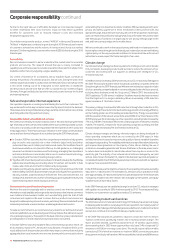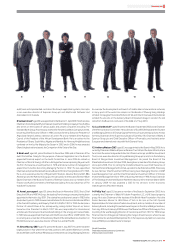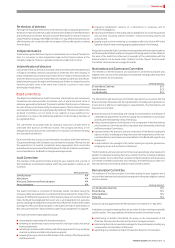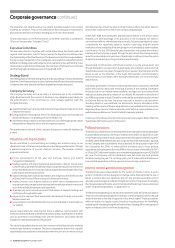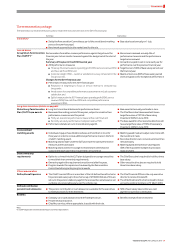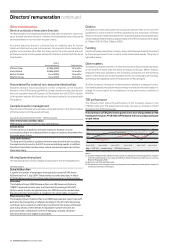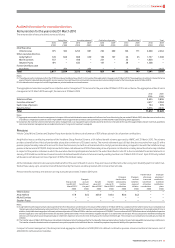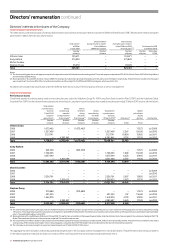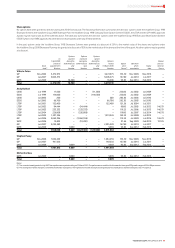Vodafone 2010 Annual Report Download - page 57
Download and view the complete annual report
Please find page 57 of the 2010 Vodafone annual report below. You can navigate through the pages in the report by either clicking on the pages listed below, or by using the keyword search tool below to find specific information within the annual report.
Governance
Vodafone Group Plc Annual Report 2010 55
Monitoring and review activities
There are clear processes for monitoring the system of internal control and reporting
any significant control failings or weaknesses together with details of corrective
action. These include:
a formal annual confirmation provided by the chief executive and chief financial
officer of each Group company certifying the operation of their control systems
and highlighting any weaknesses, the results of which are reviewed by regional
management, the Audit Committee and the Board;
a review of the quality and timeliness of disclosures undertaken by the Chief
Executive and the Chief Financial Officer which includes formal annual meetings
with the operating company or regional chief executives and chief financial
officers and the Disclosure Committee;
periodic examination of business processes on a risk basis including reports on
controls throughout the Group undertaken by the Group internal audit
department who report directly to the Audit Committee; and
reports from the external auditors on certain internal controls and relevant
financial reporting matters presented to the Audit Committee and management.
Any controls and procedures, no matter how well designed and operated, can
provide only reasonable and not absolute assurance of achieving the desired control
objectives. Management is required to apply judgement in evaluating the risks we
face in achieving our objectives, in determining the risks that are considered
acceptable to bear, in assessing the likelihood of the risks concerned materialising,
in identifying our ability to reduce the incidence and impact on the business of risks
that do materialise and in ensuring that the costs of operating particular controls are
proportionate to the benefit.
A Risk Council meets twice a year to evaluate the risks that the business is facing and
reports back to the Executive Committee and the Audit Committee which in turn
report to the Board. The Risk Council is chaired by the Group Chief Financial Officer,
facilitated by the Group Audit Director and attended by representatives from the
three geographic regions, finance, mergers and acquisitions, strategy, technology,
legal, external affairs and human resources.
Review of effectiveness
The Board and the Audit Committee have reviewed the effectiveness of the internal
control system, including financial, operational and compliance controls and risk
management, in accordance with the Combined Code for the period from 1 April
2009 to 18 May 2010, the date of approval of our annual report. No significant failings
or weaknesses were identified during this review. However had there been any such
failings or weaknesses, the Board confirms that necessary actions would have been
taken to remedy them.
Disclosure controls and procedures
We maintain “disclosure controls and procedures”, as such term is defined in Rule
13a-15(e) of the Exchange Act, that are designed to ensure that information required to
be disclosed in reports that we file or submit under the Exchange Act is recorded,
processed, summarised and reported within the time periods specified in the Securities
and Exchange Commission rules and forms, and that such information is accumulated
and communicated to management, including our Chief Executive and Chief Financial
Officer as appropriate, to allow timely decisions regarding required disclosure.
The directors, the Chief Executive and the Chief Financial Officer have evaluated the
effectiveness of the disclosure control s and procedures and, based on that evaluation,
have concluded that the disclosure controls and procedures are effective at the end
of the period covered by this document.
Going concern
The going concern statement required by the Listing Rules and the Combined Code
is set out in the Directors’ statement of responsibility on page 69.
Auditors
Following a recommendation by the Audit Committee, and in accordance with
Section 489 of the Companies Act 2006, a resolution proposing the reappointment
of Deloitte LLP as our auditors will be put to the shareholders at the 2010 AGM. We
do not indemnify our external auditors.
In its assessment of the independence of the auditors and in accordance with the US
Public Company Accounting Oversight Board’s standard on independence, the Audit
Committee receives in writing details of relationships between the Company and
Deloitte LLP that may have a bearing on their independence and receives
confirmation that they are independent of the Company within the meaning of the
securities laws administered by the SEC.
In addition, the Audit Committee pre-approves the audit fee after a review of both the
level of the audit fee against other comparable companies, including those in the
telecommunications industry, and the level and nature of non-audit fees, as part of
its review of the adequacy and objectivity of the audit process.
In a further measure to ensure auditor independence is not compromised, policies
provide for the pre-approval by the Audit Committee of permitted non-audit services
by Deloitte LLP. For certain specific permitted services the Audit Committee has pre-
approved that Deloitte LLP can be engaged by management subject to specified fee
limits for individual engagements and fee limits for each type of specific service
permitted. For all other services, or those permitted services that exceed the specified
fee limits, the Chairman of the Audit Committee, or in his absence another member, can
pre-approve services which have not been pre-approved by the Audit Committee.
In addition to their statutory duties, Deloitte LLP are also employed where, as a result
of their position as auditors, they either must, or are best placed to, perform the work
in question. This is primarily work in relation to matters such as shareholder circulars,
Group borrowings, regulatory filings and certain business acquisitions and disposals.
Other work is awarded on the basis of competitive tender.
During the year Deloitte LLP and its affiliates charged the Group £9 million (2009: £8
million, 2008: £7 million) for audit and audit-related services and a further £1 million
(2009: £1 million, 2008: £2 million) for non-audit assignments. An analysis of these
fees can be found in note 4 to the consolidated financial statements.
US listing requirements
On 29 October 2009 the Company transferred its american depositary shares from
the New York stock exchange to the NASDAQ Stock Market LLC (‘NASDAQ’). We are
subject to the rules of NASDAQ as well as US securities laws and the rules of the SEC.
NASDAQ requires US companies listed on the exchange to comply with NASDAQ’s
corporate governance rules but foreign private issuers, such as the Company, are
exempt from many of those rules. However pursuant to NASDAQ Listing Rule 5615
we are required to disclose a summary of any material ways in which the corporate
governance practices we follow differ from those required by NASDAQ for US
companies. The material differences are as follows:
Independence
The NASDAQ rules require that a majority of the Board be comprised of
independent directors and the rules include detailed definitions that US
companies must use for determining independence.
The Combined Code requires a company’s board of directors to assess and make
a determination as to the independence of its directors.
While the Board does not explicitly take into consideration NASDAQ’s detailed
definitions, it has carried out an assessment based on the requirements of the
Combined Code and has determined in its judgement that all of the non-executive
directors are independent within those requirements. At 18 May 2010 the Board
comprised the Chairman, four executive directors and nine non-executive directors.
Committees
NASDAQ rules require US companies to have a nominations committee, an audit
committee and a compensation committee, each composed entirely of independent
directors, with the nominations committee and audit committee required to have a
written charter that addresses the committees’ purpose and responsibilities.
Our Nominations and Governance Committee and Remuneration Committee
have terms of reference and composition that comply with the Combined Code’s
requirements.
The Nominations and Governance Committee is chaired by the Chairman of the
Board and its other members are non-executive directors of the Company and the
Chief Executive.
The Remuneration Committee is composed entirely of non-executive directors
whom the Board has determined to be independent.
The Audit Committee is composed entirely of non-executive directors whom the
Board has determined to be independent and who meet the requirements of Rule
10A-3 of the Exchange Act.



